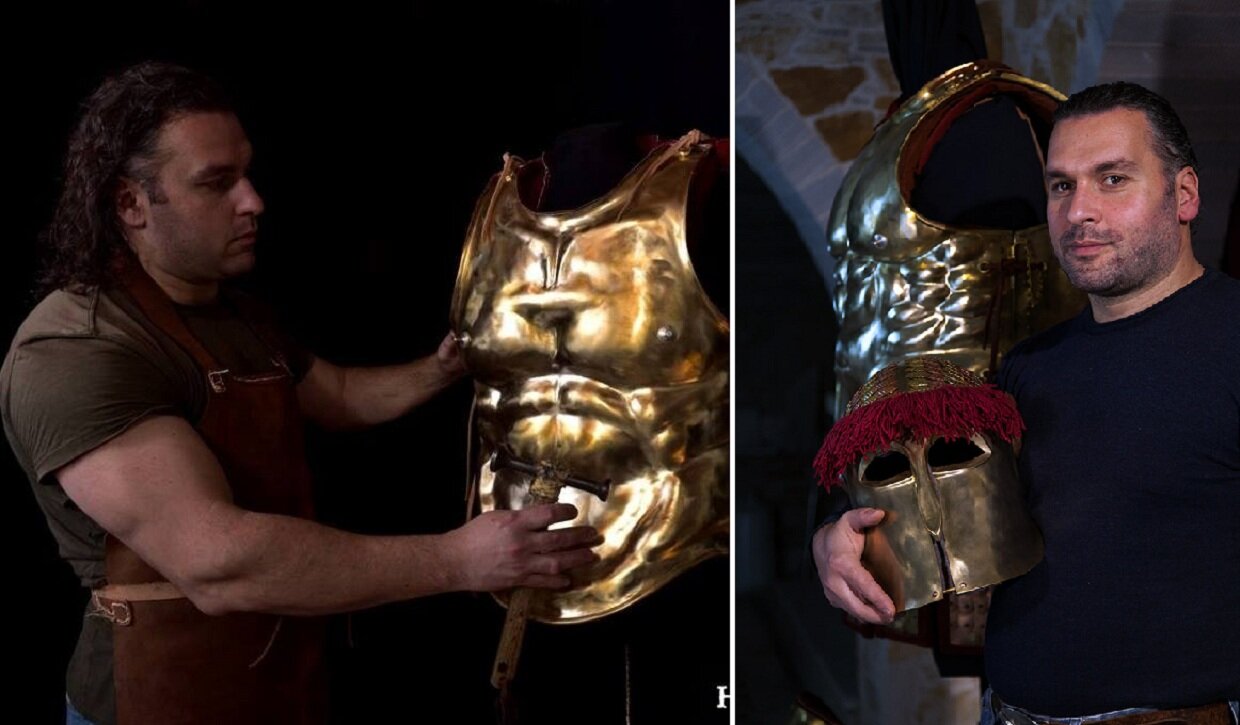Dimitris Katsikis from Spata quite literally “brings Greek history to life” within the walls of his workshop. Surrounded by tools and materials, he meticulously crafts artifacts that echo the glory of ancient Greece, transforming raw materials into vivid reminders of a bygone era.
Great Alexander's Muscle cuirass. 4th century B.C.
With a hammer in hand and an array of specialized tools, Dimitris Katsikis meticulously crafts armor from metal and leather, recreating pieces from a distant past. His creations are nothing short of masterpieces, with each one capturing the grandeur and spirit of ancient Greece. Among his most impressive works is his latest achievement—an exact replica of the armor worn by King Philip II of Macedonia.
The Armor of King Philip II
The armor of Philip II (359-336 BC) was discovered in the burial chamber of the Macedonian king, surrounded by valuable offerings meant to accompany him into the afterlife. This extraordinary find was unearthed during the 1977 archaeological excavation led by Professor Manolis Andronikos at the royal Macedonian tombs of Megali Toumpa in Vergina. Today, the original armor is proudly displayed in the Aiges Museum, alongside other significant treasures from the excavation.
“For the reproduction, I used leather, silk, bronze, and lion head embellishments to replicate the original gold details,” Katsikis explains, his eyes gleaming with passion. “These elements cover the metal frame of the armor, bringing it to life with vibrancy and brilliance. This armor was nothing less than a jewel for Philip—a treasure so valuable that he chose to carry it with him into the afterlife.” He emphasizes, “The techniques used for the construction remained exclusively traditional, preserving the authenticity and spirit of the ancient craftsmanship.”
Through his dedication to historical accuracy and artisanal excellence, Dimitris Katsikis not only recreates ancient armor but also revives the legacy of Greek history, allowing modern admirers to glimpse the splendor of a heroic age.
The Armor of Alexander the Great
One of the greatest challenges Dimitris Katsikis faced was “reviving” the linen cuirass of Alexander the Great’s armor, as depicted in the renowned "Alexander Mosaic." This ancient masterpiece portrays the Macedonian conqueror defeating King Darius III at the Battle of Issus in 333 BC. “This linen cuirass is just one of the possible versions of Alexander the Great’s armor,” Katsikis explains. “It was incredibly difficult—I had to merge many elements to breathe life back into an image—a 2,100-year-old mosaic. My goal was to restore it to its natural form, in all its majestic glory.”
The version he crafted, shown in the photographs, represents the heavy type of cuirass, characterized by all the distinctive features befitting the top ranks of Macedonian military leadership. Linen cuirasses like this one continued to be used during the Hellenistic period, serving as both protection and a symbol of authority. Remarkably, this reconstructed armor weighs about 17 kilograms, reflecting the substantial protection required by warriors of such high status.
Through his meticulous craftsmanship, Katsikis bridges the ancient and modern worlds, allowing us to witness the magnificence of Alexander’s era firsthand.
Dimitris Katsikis began his journey into the art of armor-making in 2009. With unwavering dedication and meticulous attention to detail, each armor takes him at least three months to complete. His passion for historical accuracy led him to start with creations from the Byzantine period, using the hagiographies of Agios Georgios as his initial “model.”
Since then, he has crafted an impressive collection of 25 different armors, each representing distinct phases of Greek history. From the heroic age of ancient Greece to the grandeur of the Byzantine Empire, his works not only showcase his exceptional skill but also serve as a testament to Greece’s rich martial heritage.
Through his creations, Katsikis preserves and celebrates the legacy of Greek warriors, ensuring that their stories continue to inspire future generations.
A Modern Blacksmith Revives the Armor of Alexander the Great and King Philip II
Masterpieces of Greek Armor Art
“The works I single out are four, and they represent pivotal stages in Greek armor production and Greek art,” says Dimitris Katsikis with pride. “First is the reconstruction of the oldest intact armor in the world, dating back to the 15th century BC, discovered in the village of Dendra in Argolis. Then, there is the completion of a bronze Athenian armor from the late 5th century BC, which showcases the evolution of military craftsmanship in classical Greece. I also recreated the cuirass of Philip II (4th century BC), capturing the elegance and power of Macedonian royalty. Finally, the reconstruction of the armor of St. Theodore of Tyre, as depicted by Emmanuel Panselinos in the late 12th century AD, stands out as perhaps the most advanced armor in world history in terms of design.”
These exceptional works not only highlight the development of Greek armor but also demonstrate Katsikis’ unparalleled skill and dedication to authenticity. Each piece is crafted with historical precision, bringing ancient warriors’ protection and artistry back to life.


















